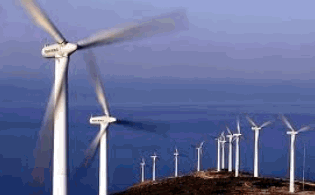|
|
|
|
|
|
|
News & Views item - June 2013 |
![]() What is the Long-Term Global and Local Effect of Large-Scale Wind Energy
Harvesting? (June 25, 2013)
What is the Long-Term Global and Local Effect of Large-Scale Wind Energy
Harvesting? (June 25, 2013)
A letter reprinted in the Union of Concerned Scientists' (UCS) publication Catalyst asks: "What is the long-term global and local effect of large-scale wind energy harvesting? There must be one: weather is a system, and taking energy out of a system means it will change. Has anyone studied this? There has to be a limit of some kind at some point."
Steve Clemmer, director of research and analysis, for the UCS Climate and Energy Program, penned this reply:
 It
is true that as the number of wind turbines at a given site increases, the speed
of the wind moving through the site decreases, which affects those turbines
downwind. Wind developers take this “wind drag” or “wake loss” into account
(along with other factors) when siting turbines in order to ensure optimal
electricity generation.
It
is true that as the number of wind turbines at a given site increases, the speed
of the wind moving through the site decreases, which affects those turbines
downwind. Wind developers take this “wind drag” or “wake loss” into account
(along with other factors) when siting turbines in order to ensure optimal
electricity generation.
While more research is needed, a few recent studies estimate that large-scale
development of wind power may be limited to around one watt per square meter of
land (W/m2) when wind drag is taken into account. Fortunately, we have a long
way to go before this level of density is reached: a 2012 study by the National
Renewable Electricity Laboratory found that wind power could reliably supply
about 40 percent of U.S. electricity use by 2050—up from 3.5 percent in
2012—with a production density of only 0.02 W/m2 averaged across the
48 contiguous states.
Wind production density will be higher in states with greater wind potential,
but still not approaching the estimated upper limit. For example, Texas, which
already leads the nation in installed wind capacity, has the potential to meet
all of its electricity needs with a production density of only 0.08 W/m2.
Some studies have shown that wind turbines can have an effect on local climatic
conditions: because turbine blades mix the air, they tend to make surface air
temperatures slightly warmer at night and slightly cooler during the day.
However, these localized variations have little impact compared with the
continuing rise in Earth’s average temperature due to increased global warming
pollution from burning fossil fuels. Wind power generates no heat-trapping
emissions during operation, thereby lessening the impact our nation’s
electricity system has on the global climate.